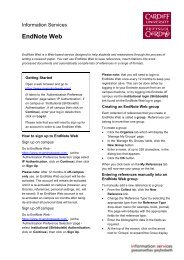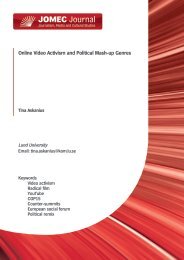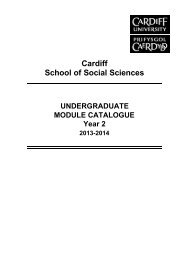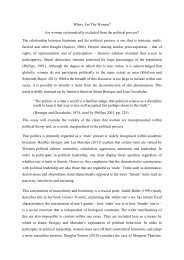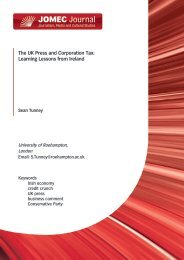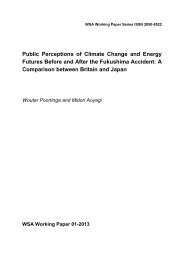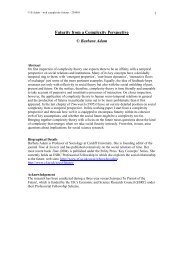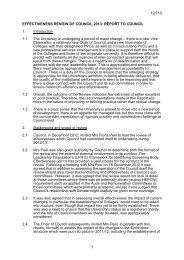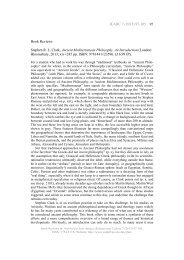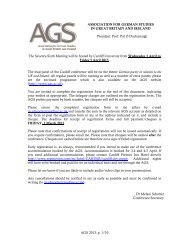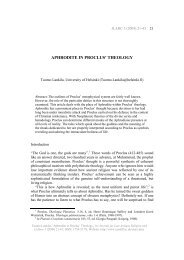Equal Pay Duty Briefing Note for the NHS CEHR - Cardiff University
Equal Pay Duty Briefing Note for the NHS CEHR - Cardiff University
Equal Pay Duty Briefing Note for the NHS CEHR - Cardiff University
You also want an ePaper? Increase the reach of your titles
YUMPU automatically turns print PDFs into web optimized ePapers that Google loves.
Welsh Specific <strong>Equal</strong>ity<br />
Duties<br />
‘<strong>Equal</strong> <strong>Pay</strong> <strong>Duty</strong>’<br />
<strong>Briefing</strong> <strong>Note</strong><br />
Dr Alison Parken. March 2012<br />
(Version 2 - updated November 2012)<br />
Date 2012<br />
01443 233450<br />
<br />
www.wales.nhs.uk/equality
Introduction<br />
The intention of <strong>the</strong> Employment <strong>Duty</strong> in relation to pay is to begin to address <strong>the</strong><br />
underlying causes of pay disparities. The reasons <strong>for</strong> pay inequalities vary at <strong>the</strong><br />
level of <strong>the</strong> workplace and are often greater than <strong>the</strong> picture given by aggregate<br />
data. Most importantly, it is employers who have <strong>the</strong> ability to collect and analyse<br />
work<strong>for</strong>ce data and <strong>the</strong> levers to change working practices. This briefing note<br />
summarises some of <strong>the</strong> issues that lead to pay disparities and suggests fur<strong>the</strong>r<br />
sources of in<strong>for</strong>mation.<br />
The ‘<strong>Equal</strong> <strong>Pay</strong> <strong>Duty</strong>’<br />
A listed body in Wales must collect and publish data, on an annual basis, <strong>the</strong> number<br />
of people employed by <strong>the</strong> authority on 31 st March each year by protected<br />
characteristic, and men and women employed by:<br />
<br />
<br />
<br />
<br />
<br />
job<br />
grade (where grading system in place)<br />
pay<br />
contract type (including permanent and fixed term contracts)<br />
working pattern (including full time, part time and o<strong>the</strong>r flexible working<br />
patterns).<br />
Since it is unlikely that any public body has no gender pay gap, an equality objective<br />
is likely to flow from <strong>the</strong> data ga<strong>the</strong>ring, in which case an action plan is also<br />
required 1 .<br />
How do pay inequalities arise?<br />
<strong>Pay</strong> disparities result from a combination of differences in <strong>the</strong> ways men and women<br />
are employed. These factors include employment segregation (by sector,<br />
occupation, workplace hierarchy, contract type (permanent/casual, full or part time or<br />
fixed hours), <strong>the</strong> undervaluing of ‘women’s work’, access to training and routes to<br />
progression, <strong>the</strong> unequal division of labour between paid and unpaid work, labour<br />
market structuring on <strong>the</strong> assumption of gender roles regarding childcare and adult<br />
dependent care in <strong>the</strong> working age years, and pay discrimination.<br />
In combination, <strong>the</strong>se cultural factors combine with labour market systems so that<br />
disabled people and people from some ethnic minorities can be clustered in low skill<br />
occupations within organisations, even though many have qualifications that should<br />
lead to skilled work 2 . Older people can suffer from per<strong>for</strong>mance stereotyping where<br />
1 See <strong>the</strong> EHRC guide to <strong>the</strong> Welsh Specific Duties on employment and pay:<br />
http://www.equalityhumanrights.com/wales/publications/public-sector-equality-duty-in-wales/<br />
2 See Davies, R., Drinkwater, S., Joll, C., Jones, M., Lloyd-Williams, H., Makepeace, G., Parhi, M., Parken, A.,<br />
Robinson, C., Taylor, C., and Wass, V. (2011) An Anatomy of Economic Inequality in Wales, A report prepared<br />
Welsh Specific <strong>Equal</strong>ity Duties<br />
<strong>Equal</strong> <strong>Pay</strong> <strong>Briefing</strong> <strong>Note</strong>, Dr Alison<br />
Parken<br />
Page 2 of 7 Version 2<br />
November 2012
<strong>the</strong>ir experience is no longer seen as relevant, while younger people can be viewed<br />
as lacking practical skills and so find it difficult to gain experience.<br />
<strong>Pay</strong> discrimination may be <strong>the</strong> least of <strong>the</strong> causal factors. The traditional, equal<br />
treatment approach to discovering and addressing gender pay gaps requires<br />
individual men and women to find comparators in <strong>the</strong>ir workplaces but as <strong>the</strong><br />
following aggregate, or whole economy figures show, when men and women are in<br />
such different kinds of occupations and with different employment contracts,<br />
comparison is difficult 3 .<br />
Occupational Segregation<br />
Table 1 (below) shows that management and professional occupations in<br />
agriculture, manufacturing and construction are largely a male domain.<br />
Table 1: Gender and Occupation in Wales, 2008<br />
Men Women Total Women<br />
as % of<br />
total<br />
Managers and Senior Officials – All<br />
industries<br />
111,400 62,800 174,600 35%<br />
Managers and Senior Officials –<br />
Agriculture, fishing; energy and water; 39,200 8,000 47,400 17%<br />
manufacturing; construction<br />
Managers and Senior Officials -<br />
Distribution, hotels, restaurants; transport<br />
and communication; banking finance and 72,300 54,800 127,200 43%<br />
insurance etc.; public administration,<br />
education and health and o<strong>the</strong>r services.<br />
Professionals – All industries 87,800 70,500 158,300 45%<br />
Professionals – Agriculture etc. 20,500 2,300 23,100 10%<br />
Professionals – Distribution etc. 67,400 67,700 135,100 51%<br />
Associate Professional and Technical<br />
– All industries<br />
79,300 93,500 172,800 54%<br />
Associate Professional and Technical –<br />
Agriculture etc.<br />
16,200 6,500 22,600 29%<br />
Associate Professional and Technical –<br />
63,100 87,000 150,200 58%<br />
Distribution etc.<br />
Source: Annual Population Survey January 2008 – December 2008. Wales. NOMIS. Data Run:<br />
195009, extrapolated 22/07/09. Numbers and percentages rounded up.<br />
on behalf of <strong>the</strong> Wales <strong>Equal</strong>ity and Human Rights Commission, <strong>Cardiff</strong>: EHRC pp. 215<br />
http://www.wiserd.ac.uk/research/completed-projects/inequality-in-wales/<br />
3 Parken, A., Rees, T. and Baumgardt, A. (2009) Options <strong>for</strong> an equal pay duty in Wales, <strong>Cardiff</strong>:<br />
Welsh Assembly Government pp. 36<br />
Welsh Specific <strong>Equal</strong>ity Duties<br />
<strong>Equal</strong> <strong>Pay</strong> <strong>Briefing</strong> <strong>Note</strong>, Dr Alison<br />
Parken<br />
Page 3 of 7 Version 2<br />
November 2012
The figures show that men predominate as Managers and Senior Officials overall<br />
and absolutely numerically dominate in industries such as agriculture, manufacturing<br />
and construction. No women senior managers were recorded at all in <strong>the</strong> subcategory<br />
‘energy and water’.<br />
Men also dominate <strong>the</strong> category of Managers and Senior Officials within <strong>the</strong> large<br />
‘services’ category (‘distribution etc’) but <strong>the</strong>re is a near gender balance within <strong>the</strong><br />
Professionals working in ‘services 4 . However, of <strong>the</strong> 67,700 professional women in<br />
Wales employed in this category, 57,500 or 85% were working within occupations in<br />
public administration, education, health and o<strong>the</strong>r services.<br />
In Associate Professional and Technical jobs, 62,500 of <strong>the</strong> 87,000 women in<br />
distribution and o<strong>the</strong>r industries were again working within ‘public administration,<br />
education and health’.<br />
Overall, more women work in <strong>the</strong> private sector than <strong>the</strong> public sector but <strong>the</strong>se<br />
figures, showing <strong>the</strong> distribution of women’s higher grade employment by sector and<br />
occupation, demonstrate <strong>the</strong> importance of employment in <strong>the</strong> public sector <strong>for</strong><br />
women. Indeed, research <strong>for</strong> <strong>the</strong> UK as a whole shows that is it only women working<br />
in <strong>the</strong> public sector with higher education qualifications who continue to have career<br />
and pay progression beyond <strong>the</strong> age of 35 (Hills et al 2010:388) 5 , compared to men<br />
whose pay progression continues beyond this age, with lower qualifications, and in<br />
all sectors.<br />
Contract Segregation<br />
A key factor in maintaining pay disparities is <strong>the</strong> distribution of part time work and its<br />
association with low pay. Besides working predominately in different sectors of <strong>the</strong><br />
economy, variation in <strong>the</strong> ways men and women are contracted has a substantial<br />
effect upon pay disparities.<br />
Men hold 62% of all full time employee jobs in Wales, women hold 38%<br />
(Davies et.al. 2011).<br />
Women hold 79% of all part time employee jobs in Wales (Parken 2011)<br />
<br />
<br />
The gap between men’s full time median hourly and women’s part time<br />
median hourly is 34% (LFS 2009).<br />
Women are <strong>the</strong> majority of those earning less than minimum wage and of<br />
those earning less than £7.00 per hour (Parken 2009).<br />
4 Table abstracted from, Parken, A. and Rees, T. (2011) ‘Economic renewal and <strong>the</strong> gendered<br />
knowledge economy in Wales’, Contemporary Wales, Vol. 24, <strong>Cardiff</strong>: <strong>University</strong> of Wales Press<br />
5 http://eprints.lse.ac.uk/28344/1/CASEreport60.pdf<br />
Welsh Specific <strong>Equal</strong>ity Duties<br />
<strong>Equal</strong> <strong>Pay</strong> <strong>Briefing</strong> <strong>Note</strong>, Dr Alison<br />
Parken<br />
Page 4 of 7 Version 2<br />
November 2012
58% of mo<strong>the</strong>rs / 90% of fa<strong>the</strong>rs of children under 5 are economically active<br />
(32% gap) (Parken 2009).<br />
Again we can see how individual pay comparisons are difficult when men hold so<br />
many more of <strong>the</strong> total of full time jobs. Something more structural is happening in<br />
<strong>the</strong> labour market. It is often assumed that women choose to work part time, this is<br />
true of some women at some points in <strong>the</strong>ir working lives - at any one point in time<br />
around 40% of part time workers have a caring responsibly. The <strong>Equal</strong> <strong>Pay</strong> <strong>Duty</strong> will<br />
require employers to look at <strong>the</strong>ir employment data and ask questions such as: Why<br />
is part time work offered as <strong>the</strong> only option in certain jobs <strong>for</strong> women, whilst flexibility<br />
is gained from men in employment through shift-working and overtime (with<br />
attendant pay benefits)? Contracting men to work part time is increasing. Data<br />
collection and analysis is needed to reveal such patterns of change in working<br />
practices and <strong>the</strong>ir impacts on pay.<br />
A discussion about ‘choice’, human capital <strong>the</strong>ory and part time working can be<br />
found in <strong>the</strong> report ‘An Anatomy of Inequality in Wales’ (Davies et. al 2011, Chapter<br />
7.4, p170). This report is a rich source of recent and relevant in<strong>for</strong>mation. It shows<br />
that:<br />
‘… women in Wales face an above-average incidence of low hourly pay<br />
(less than 2/3 of median UK hourly earnings): 26% <strong>for</strong> all employees in<br />
Wales, but 32% <strong>for</strong> women). Part-time workers face an additional risk of<br />
low pay. The probability of low hourly earnings is more than twice as high<br />
<strong>for</strong> women who work part time (47%) as full-time (22%)’. (Davies et.al.<br />
p.144) 6 .<br />
Low paid part time work may also disproportionately be offered to women and men<br />
from some ethnic minorities and disabled people, whilst older staff of ei<strong>the</strong>r gender,<br />
in higher grade jobs may find part time work is unavailable to <strong>the</strong>m. Data ga<strong>the</strong>ring,<br />
under <strong>the</strong> <strong>Equal</strong> <strong>Pay</strong> <strong>Duty</strong>, will enable employers to analyse how part time and<br />
flexible working is distributed in <strong>the</strong>ir workplaces by protected characteristics.<br />
Given <strong>the</strong> predominance of women employed in <strong>the</strong> public sector, and <strong>the</strong><br />
disproportionate distribution of women managers and professionals within <strong>the</strong><br />
occupational category of education, health and public administration, we would<br />
expect small pay gaps in <strong>the</strong> public services in Wales. Un<strong>for</strong>tunately, <strong>the</strong> effect of,<br />
contract segregation is also apparent in <strong>the</strong> public sector in relation to part time work<br />
and pay.<br />
Occupational and pay segregation in <strong>the</strong> Public Sector in Wales<br />
6 Davies, R., Drinkwater, S., Joll, C., Jones, M., Lloyd-Williams, H., Makepeace, G., Parhi, M.,<br />
Parken, A., Robinson, C., Taylor, C., and Wass, V. (2011) An Anatomy of Economic Inequality in<br />
Wales, A report prepared on behalf of <strong>the</strong> Wales <strong>Equal</strong>ity and Human Rights Commission, <strong>Cardiff</strong>:<br />
EHRC pp. 215 http://www.wiserd.ac.uk/research/completed-projects/inequality-in-wales/<br />
Welsh Specific <strong>Equal</strong>ity Duties<br />
<strong>Equal</strong> <strong>Pay</strong> <strong>Briefing</strong> <strong>Note</strong>, Dr Alison<br />
Parken<br />
Page 5 of 7 Version 2<br />
November 2012
In Local Government in Wales:<br />
‘….. men are just 28 per cent of <strong>the</strong> local government work<strong>for</strong>ce but hold<br />
44 per cent of full time permanent contracts .... women, are 72 per cent<br />
of employees in total [in local government] but hold 56 per cent of <strong>the</strong> full<br />
time permanent contracts. Women on <strong>the</strong>se contracts account <strong>for</strong> only 36<br />
per cent of women employed in local government. Overwhelmingly<br />
women’s labour is contracted part time and particularly part time casual.<br />
Women hold 86 per cent of part time casual jobs, and of all women<br />
working in local government 60 per cent are contracted part time’<br />
(Parken, Rees and Baumgardt 2009:9).<br />
Table 2 (below) shows employment and pay data by employment contract <strong>for</strong> <strong>the</strong><br />
Welsh Public Sector as a whole. The data shows a disproportionate gender ratio of<br />
full time jobs <strong>for</strong> men and a disproportionately high use of part time working <strong>for</strong><br />
women.<br />
Table 2 – Employment by Gender Contract and <strong>Pay</strong> in <strong>the</strong> Welsh Public Sector<br />
Source Table 7.1 (Parken in Davies et al 2011)<br />
Men<br />
Women<br />
Employees Hourly<br />
Earnings<br />
Employees Hourly<br />
Earnings<br />
Full Time Perm 93,528 12.80 117,946 11.07<br />
Part Time<br />
8,732 8.06 65,313 8.28<br />
Perm<br />
Full Time<br />
5,049 7.87 9,137 9.52<br />
Casual<br />
Part Time<br />
2,197 7.30 8,288 7.05<br />
Casual<br />
Total 109,236 200,684<br />
<br />
<br />
<br />
<br />
<br />
<br />
Women are two thirds of all employees in <strong>the</strong> Welsh public sector.<br />
Men are 35% of total employees and hold 44% of all full time (FT) permanent<br />
jobs.<br />
Full time work accounts <strong>for</strong> 90% of all men’s employment.<br />
Women are 65% of total employees but hold 56% of all FT permanent jobs.<br />
Women hold 88% of all part time permanent jobs.<br />
63% of women are employed FT, and 37% PT.<br />
Women are 86% of <strong>the</strong> overall part time work<strong>for</strong>ce, men 14%.<br />
These working patterns contribute to an hourly median gender pay gap between<br />
men and women on permanent contracts who work full time (excluding overtime) of<br />
14% or £1.75 per hour. Between women, <strong>the</strong> difference <strong>for</strong> those on permanent full<br />
Welsh Specific <strong>Equal</strong>ity Duties<br />
<strong>Equal</strong> <strong>Pay</strong> <strong>Briefing</strong> <strong>Note</strong>, Dr Alison<br />
Parken<br />
Page 6 of 7 Version 2<br />
November 2012
time contracts and women on permanent part time contracts is £2.79 per hour, or<br />
25%. The gap between <strong>the</strong>se part time women and full time men is £4.54 per hour<br />
or 35%.<br />
In qualitative research with a local authority, colleagues and I found that women<br />
contracted to work 10, 14, or 18 hours per week often worked 21, 24 or 28 hours per<br />
week (Parken and Baumgardt 2009) 7 . They received no overtime pay <strong>for</strong> <strong>the</strong>se<br />
additional hours as <strong>the</strong>y didn’t exceed <strong>the</strong> bar <strong>for</strong> of full time working of 35 hours per<br />
week.<br />
Several of <strong>the</strong> women interviewed had, or knew of, women who had two or more<br />
low-hours employment contracts with <strong>the</strong> same local authority. None of <strong>the</strong>m had<br />
caring responsibilities; several would have welcomed <strong>the</strong> option to work full time but<br />
this was not available in <strong>the</strong>ir occupations. However, part time work wasn’t offered<br />
as an option to <strong>the</strong>ir younger, more highly educated, supervisors who did have<br />
childcare responsibilities.<br />
This example shows where working patterns offer flexibility <strong>for</strong> employers but do not<br />
work well <strong>for</strong> employees, as well as creating pay inequalities.<br />
Conclusions<br />
The equal pay element of <strong>the</strong> employment duty is designed to illuminate pay<br />
disparities at <strong>the</strong> work<strong>for</strong>ce level. It should begin to show taken <strong>for</strong> granted<br />
stereotypes about <strong>the</strong> gendering of jobs and progression - at <strong>the</strong> work<strong>for</strong>ce level<br />
where changes can be made.<br />
Employers will be able to look at <strong>the</strong> data ga<strong>the</strong>red and <strong>the</strong>n fur<strong>the</strong>r investigate <strong>the</strong><br />
reasons behind how workplace systems and practices, and wider social and cultural<br />
stereotypes, result <strong>the</strong> following kinds of outcomes:<br />
<br />
<br />
<br />
<br />
<br />
occupational ‘clustering’ by protected group characteristic<br />
pay disparities resulting from <strong>the</strong> way people are contracted to work. Can<br />
fairer working patterns be investigated?<br />
certain groups consistently working at grades below <strong>the</strong>ir qualifications level,<br />
lack of part time and flexible working options in supervisory and management<br />
level jobs, or only in certain clinical settings<br />
lack of career progression.<br />
These contributory factors in <strong>the</strong> creation of pay disparities will not be solved in one<br />
round of reporting. Ga<strong>the</strong>ring and analysing <strong>the</strong> data, setting out what fur<strong>the</strong>r<br />
7 Parken, A. and Baumgardt A. (2008) The Business Benefits of <strong>Equal</strong> <strong>Pay</strong>: Local Authority Case<br />
Study, <strong>Cardiff</strong>: <strong>Equal</strong>ity and Human Rights Commission Wales pp. 48<br />
Welsh Specific <strong>Equal</strong>ity Duties<br />
<strong>Equal</strong> <strong>Pay</strong> <strong>Briefing</strong> <strong>Note</strong>, Dr Alison<br />
Parken<br />
Page 7 of 7 Version 2<br />
November 2012
esearch is required and setting an equality objective to diminish pay disparities, will<br />
begin <strong>the</strong> process of ‘undoing-gender’ persistent pay gaps, one workplace at a time.<br />
For more in<strong>for</strong>mation, please contact us on 01443 233450<br />
or www.wales.nhs.uk/equality<br />
Welsh Specific <strong>Equal</strong>ity Duties<br />
<strong>Equal</strong> <strong>Pay</strong> <strong>Briefing</strong> <strong>Note</strong>, Dr Alison<br />
Parken<br />
Page 8 of 7 Version 2<br />
November 2012



